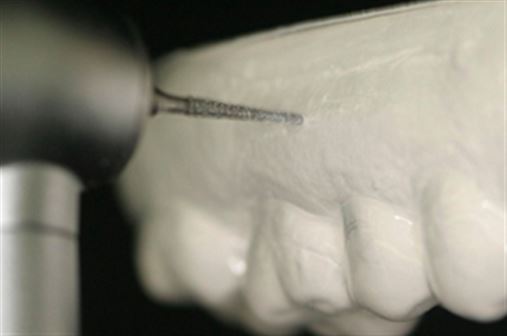Vol. 10 – Número 39 – 2017 Artigo original | Original article Página 331-340 INSTALAÇÃO DE MINI-IMPLANTES: QUAL A MELHOR IMAGEM RADIOGRÁFICA PARA AVALIAÇÃO DO ESPAÇO INTERRADICULAR? MINI-IMPLANTS PLACEMENT: WHICH IS THE BEST X-RAY IMAGINE FOR INTERRADICULAR Izabelle Alice Pinheiro Barros Lisboa1 Paulo Sérgio Flores Campos2 Nilson Pena3 Telma Martins de Araujo4 RESUMO O objetivo desse estudo foi comparar a eficácia entre a tomografia computadorizada de feixe cônico (padrão-ouro) e as radiografias periapical, interproximal e panorâmica digitais para avaliação do espaço inter-radicular com vistas à instalação de mini-implantes. Métodos: a amostra foi composta por 40 sítios eleitos nos espaços inter-radiculares na região posterior. Os pontos de inserção para instalação dos mini-implantes foram representados por guta-percha em moldeira de acetato que os pacientes usavam durante as radiografias e a tomografia. Através do programa Adobe Acrobat 9 Pro Extend foram feitas medidas interradiculares no sentido horizontal nos três métodos radiográficos e comparadas com as da tomografia, que foram realizadas pelo Kodak Dental Imaging Software 3D. A comparação utilizou o coeficiente de Lin. Resultados: foi observada diferença estatisticamente significante entre a tomografia computadorizada e as radiografias panorâmicas (27,8% – P > 0,05). Conclusões: a radiografia interproximal foi o método mais preciso; a radiografia panorâmica e a periapical não são recomendadas para verificação do espaço inter-radicular, pois apresentaram alteração da dimensão dessa região no sentido horizontal. Descritores: Tomografia computadorizada por Raios X, diagnóstico por imagem, radiografia dentária, procedimentos de ancoragem ortodôntica. ABSTRACT The objective of this study was to compare the assessment of interradicular space for mini-implants fitting between the cone beam computed tomography (gold standard) and periapical, interproximal and panoramic digital radiographies. Methods: The sample consisted of 40 elected interradicular sites in the posterior area of five patients. These areas were represented by gutta percha points in acetate trays that patients used when radiographies and tomographies were taken. Horizontal measures, between dental roots, in three radiographic methods were obtained by Adobe Acrobat 9 Pro Extend program and compared with the tomography obtained by Kodak Dental Imaging Software 3D. The comparison was done by Lin coefficient correlation. Results: there was not stastistically difference between tomoghaphy and interproximal radiography (8,4% – p < 0,05). Conclusions: the interproximal radiography was the most accurate radiographic method; the panoramic and periapical radiographies are not recommended for interradicular space verification, because they present horizontal dimension alterations in this region. Descriptors: X-Ray computed tomography, diagnostic imaging, dental radiography, orthodontic anchorage procedures 1 Ortodontista – UFBA. 2 Mestrado em Odontologia – UFBA, Doutorado em Diagnóstico Bucal, subárea de Radiologia e Livre-Docência em Radiologia – FO/USP, Professor Participante do Programa de Pós-Graduação em Radiologia – FOP/UNICAMP. 3 Doutorado em Radiologia Odontológica – UNICAMP, Pós-Graduação em Odontologia – UFBA. 4 Doutorado em Odontologia – UFRJ, Mestrado em Odontologia – UFRJ, Professora Titular – UFBA.
This content is restricted to site members. If you are an existing user, please log in. New users may register below.




